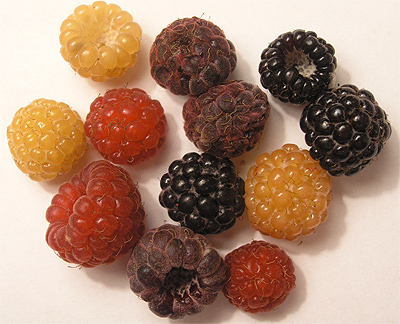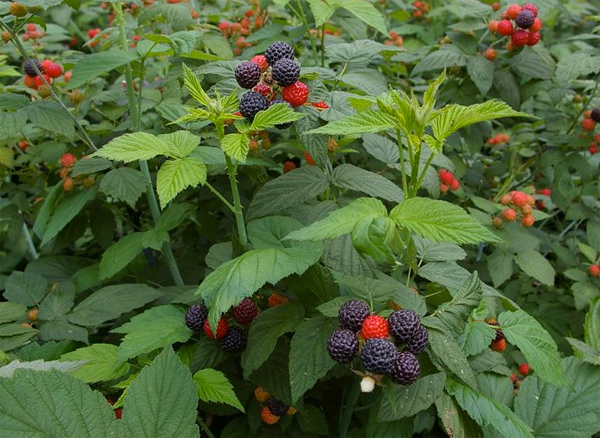 image via Wikimedia
image via Wikimedia
There are various types of raspberries, and include summer-bearers, which produce one crop, and ever-bearers, which produce a crop in the summer and another, lighter flush of berries in the fall. Raspberries come in red, yellow, gold, black, and purple.
Raspberries - Not the Same as Blackberries
Blackberries are not simply black raspberries. Unripe blackberries are greenish-red to red, and turn purplish-black as they ripen. The color at maturity depends on the subspecies or variety of raspberry you've planted.
 This is a blackberry (not a black raspberry).
This is a blackberry (not a black raspberry).Image from Wikipedia.
The easiest way to tell the difference between raspberries and blackberries is by looking at the torus, or core, of the berry. When picking blackberries, the soft white core stays inside the berry (this is termed "picks with"). Raspberries however, separate from the torus, leaving a hole or void in the middle of the berry, with the core staying on the end of the stem.
How to Grow Raspberries
Raspberries will grow in USDA zones 4-7, which covers most of the United States. Canes can produce for many years, so you will want to prepare the soil well. Dig in plenty of organic matter and make sure there is good drainage. If your soil is heavy with clay, add sand to improve drainage. Raspberries prefer a pH of about 6.0. If your soil pH is above 7.0 (which on the alkaline side), add acidic organic matter such as compost, well-rotted manure, chopped oak leaves, or a bit of sulfur. If the soil pH is too low (ie. acidic), add a small amount of lime or wood ash. However, be careful not to add too much because a little goes a long way.
Raspberries love the sun, and can become susceptible to mold or mildew if grown in close quarters, so make sure they have plenty of room. Red and golden raspberries grow better on a fence or trellis, while purple and black raspberries prefer to grow in a thicket. In zone 7, raspberries do better if they have light shade in the afternoon.
Plant canes or bare roots in the ground in early spring, 4-6 weeks before your last expected frost date. Plant canes slightly deeper than they were in their nursery container. If you decide to grow raspberries in containers, wait until the last frost has passed before bringing them outside.
In late winter, give the canes a dose of organic fertilizer. In the spring, follow up with mulch, such as sawdust, bark, or straw to help balance the pH and keep weeds away.
Pruning Raspberries
To encourage plants to produce more berries, cut new canes to four or five feet high in late summer. This will stimulate growth of lateral branches, which produce more buds, and thus, more berries for the next growing season.
To prevent crowding, cut dead canes down to the ground. 3-year-old canes should also be cut, too, as they bear weakly and will die by the next season anyway. Although raspberries are rarely bothered by pests, pruning helps control the cane borer larvae. If you see individual raspberry canes wilting, prune them six inches below the damage. Dispose of the wilted cane by burning it far from the raspberry patch so the larvae won't re-infect your plants.
Growing Raspberries in Containers
 Image from Geograph UK.
Image from Geograph UK.
Since raspberry canes tend to multiply through runners, a deep, wide container with good drainage works best. Half of a whisky barrel or wine keg with holes drilled in the bottom will work well. This works best in climates that don't have a hard freeze over the winter.
Line the bottom of the container with a weed barrier or burlap to keep the soil inside the container and fill the container most of the way with a mixture of approximately 80% potting soil and 20% garden soil. Create a hole large enough so you can set your plants slightly deeper than in their nursery containers and spread out their roots.
Raspberries in containers may need more water than those grown in the ground, so make sure they get water on a regular basis, especially when the fruit is developing. During the summer, larger pots are generally better as they'll allow you to water the plants deeply, but less often. In addition, the canes will need an all-purpose fertilizer in early spring, and pruning as needed.
Benefits of Raspberries
Raspberries are loaded with antioxidants and anti-inflammatory compounds which may fight cancer and alleviate pain. Another compound, called raspberry ketone, is being researched because it seems to help enzyme activity and metabolism, which may assist those fighting obesity and type II diabetes (the jury is still out on this one, though).
In addition, one cup of raspberries provides half the recommended amount of vitamin C for an adult, plus fiber and other nutrients. Since they're so good for you, and not difficult to grow, why not try growing a few raspberry plants in your own home garden?
Further Reading
Growing Raspberries at Mother Earth News.
